The Search for the Portrait that Belonged to Kittel Pages at The Face Of Bach
The Queens College Lecture of March 21, 2001 - Page 1 - An Odyssey Begins
The Face Of Bach
This remarkable photograph is not a computer generated composite; the original of the Weydenhammer Portrait Fragment, all that
remains of the portrait of Johann Sebastian Bach that belonged to his pupil Johann Christian Kittel, is resting gently on the surface
of the original of the 1748 Elias Gottlob Haussmann Portrait of Johann Sebastian Bach.
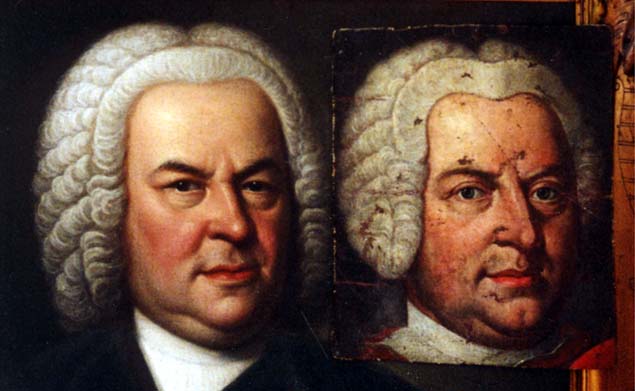
1748 Elias Gottlob Haussmann Portrait, Courtesy of William H. Scheide, Princeton, New Jersey
Weydenhammer Portrait Fragment, ca. 1733, Artist Unknown, Courtesy of the Weydenhammer Descendants
Photograph by Teri Noel Towe
©Teri Noel Towe, 2001, All Rights Reserved
The Search for the Portrait that Belonged to Kittel
The Queens College Lecture of March 21, 2001
Page 1
An Odyssey Begins
Thank you, Rufus, for such a wonderful welcome and such a glowing introduction.
It is a great honor and a particular pleasure for me to make my first public presentation on the Weydenhammer Portrait Fragment in
this room, and I am grateful not only to my old friend Rufus Hallmark, but also to my relatively new old friend Raymond Erickson,
and, of course, to President Holtzer for having made this opportunity a reality. At the outset I also want to acknowledge and say,
"thank you", for all of the help and support that I have received from Alan, Mike, Rick, Joe Ponte, Ron Cannava, Ms. Dimino, Ms.
Major, and the rest of the many people here at Queens College who have provided indispensable assistance with every facet of this
presentation. Finally, I would like to express my heartfelt thanks to my good and patient friend, Michael V. Cohen, of New York
Film Works, the city's premier photo lab. Michael is a magician with digitized images, and it is he who generated all of the slides for
me, from the scans that I have created for this presentation and for my website about the Bach iconography, the website called The
Face Of Bach, which is a functioning reality because of another magician, Nathan P. Johansen.
Today is the second time I have been in the LeFrak Concert Hall "officially". My first visit to this room was an especially joyous
occasion. I was among the throng who filled this room when Joseph Machlis, renowned Professor of Music at this institution,
author of the remarkable The Enjoyment of Music -- the most successful textbook of its kind, ever -- and my treasured friend and
mentor for 25 years, received his degree "Doctor honoris causa" from the school with which he had been so long associated. I view
that coincidence as a good omen, and, even though Joe crossed to the other side more than two years ago, I know that he is here in
spirit.
By one method of reckoning, it has taken me 48 years to get here, by another method, 38 years.
Let me begin, please, by explaining that cryptic comment.
I was 5, when I encountered Bach for the first time, thanks, surprisingly enough, to Liberace. Those among you who are old
enough, like me, to remember his television programs doubtless will recall that Liberace always found time for classical music in
each and every program, and his love of sartorial splendor found a welcome outlet in the little "costume pieces" that he made of
those classical music segments. It was in that context that I first became enamored of the complex musical wizardry that is the very
essence of the music of Johann Sebastian Bach. A fortuitous encounter a few weeks later with the Wisdom series program in which
Jack Pfeiffer interviews Wanda Landowska and her Pleyel harpsichord sealed it for good and all.
My parents encouraged my interest, and they got me one of those wonderful biography records for children that that benign
scoundrel of sainted memory, George Mendelssohn, of Vox Records, put out as part of a series of ten inch LPs in the early '50s.
This is how Bach is depicted on the jacket of that LP. (Yes, I still have it!)

This illustration, credited to the Magnavox Library, is the depiction of Bach that I had found in the family encyclopedia, the 1947
edition of the World Book:
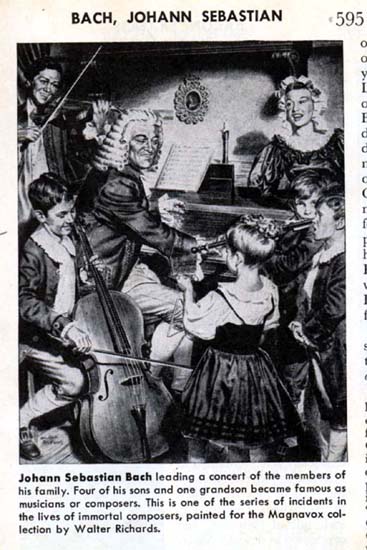
A delightful image it may be, but it is one that is full of anachronisms, and, as I shall demonstrate later, the depiction of Bach is one
that bears little resemblance to the "real" Johann Sebastian Bach.
In September of 1954, I entered the first grade at the Buckley School in New York City, and the then music teacher for the lower
grades (How I wish I could remember her name!) encouraged my self-proclaimed affection for the music of Bach by giving me a
flyer for a Bach Aria Group concert. That flyer got lost over the years, but here is the flyer for the 1956-1957 season, which is
exactly as I recall the one from 1954, except that the 1954 one was red, rather than blue.
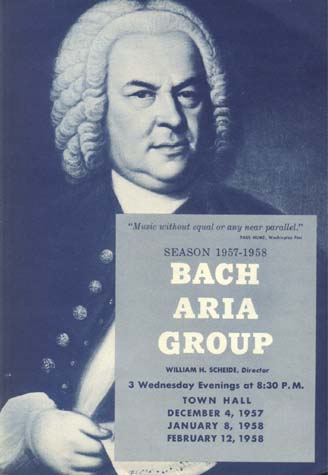

I now know that, iconographically at least, that thoughtful music teacher got me on to the right track, because the image of Bach on
those flyers, of course, is the face of the 1748 Elias Gottlob Haussmann portrait of Bach that belonged then, as it does now, to my
treasured friend and mentor, William H. Scheide, to whom I am forever indebted not only for his guidance and the rigorous
scholarly standards that he helped to instill in me but also for the invaluable insights and indispensable help with which he has
provided me since I began my work with the Weydenhammer Portrait Fragment almost one year ago. There simply are no words in
the language that are adequate to express fully the extent of my gratitude to this sublime and ever generous human being.
That same fall, my parents made a trip to Europe that included a stay in Germany. Among the souvenirs that they brought back to
me were postcard portraits of Bach. One was a color postcard of the 1746 Haussmann portrait that is in Leipzig, the other a black
and white postcard of the so-called Volbach Portrait, the one that depicts Bach in the last weeks of his life:

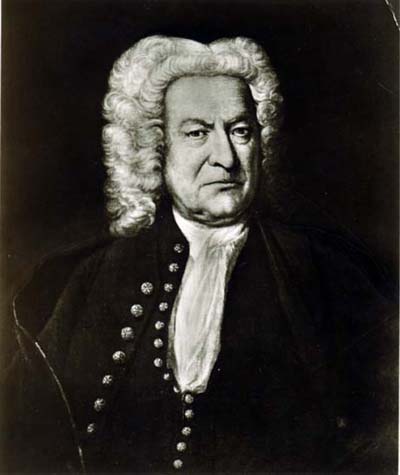
These are scans of those very postcards. Believe it or not, I still have them, too, after all of those years!
That first encounter with the 1746 Haussmann portrait and the Volbach portrait rubbed my nose in the obvious: Bach did not look
the same throughout his life.
Perhaps more importantly -- artists and publishers alike, I soon and quickly discovered, had a remarkably casual attitude about the
accuracy with which Bach's facial features were depicted.
As a Christmas gift that year, when I was 6 going on 7, I received a collection of thumbnail biographies for children entitled
Famous Composers for Young People. That book contains not one but two portraits of Bach. The frontispiece is that wonderful
late 19th century painting of the Bach family making music together, an image by T. E. Rosenthal that is significantly less
"Hollywoodish" than Walter Richards's painting for the Magnavox Collection, for which it clearly provided the inspiration:

In addition to the frontispiece, the book has a portrait of Bach at the beginning of the chapter on his life and career:
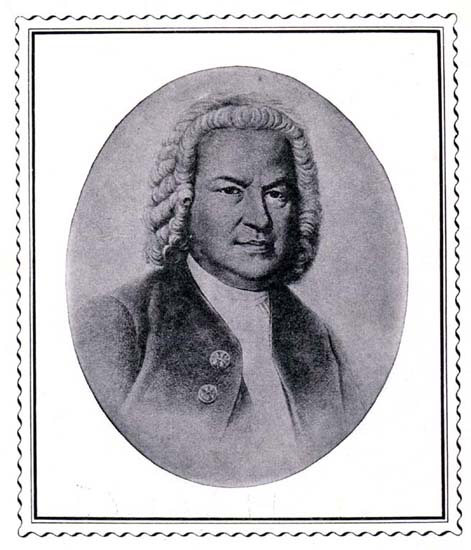
I now know this image to be derived from a print by Schlick that Robert Schumann praised highly; it dates from 1840. Schlick's
print is based on the 1746 Haussmann portrait in Leipzig, and it is a derivative that has importance to students of Bach iconography,
because it is one of the images that were modeled on, or direct copies of, the 1746 Haussmann portrait before it was subjected to
the first of at least four major "restorations":
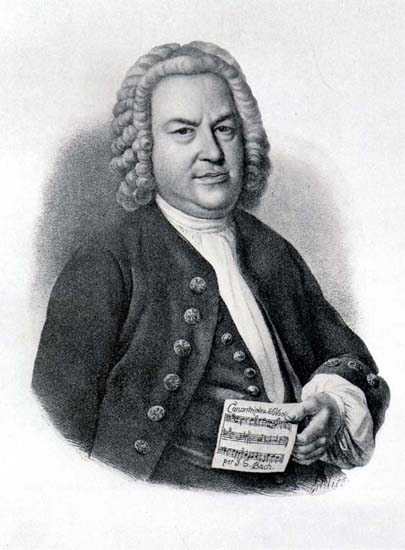
The following year, in the fall of 1955, my Mother gave me a copy of Eva Mary and Sidney Grew's biography of Bach, one of the
volumes in that era's incarnation of the renowned Master Musician series.
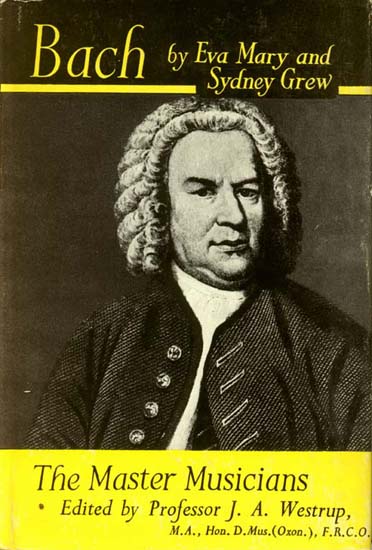
The dustjacket and frontispiece portrait is what I now know to be, in effect, the portrait engraving by Sichling, an image
scrupulously copied in 1851, from the 1746 Haussmann portrait, the year before it was subjected to the first of the at least four
"restorations":
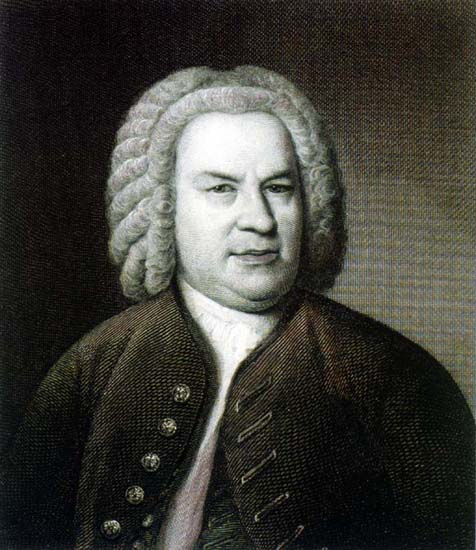
This meticulous copy is an effective image, one that has been widely disseminated, and one that depicts the essentials of Bach's
physiognomy with remarkable accuracy. Never mind that it was created more than a century after the subject's death!
A couple of winters later, one of the local super markets launched one of those periodic promotions in which the customers are
offered the opportunity to assemble a complete encyclopedia in installments of one volume per week. My mother and I rose to the
challenge, and we completed the 1957-1958 edition of the Funk & Wagnalls Home Encyclopedia. Yes, I must reinforce my
reputation as a packrat worthy of a Nobel Prize and confess that I still have that, too. The portrait of Bach that it contains is yet
another image that I had not previously encountered:
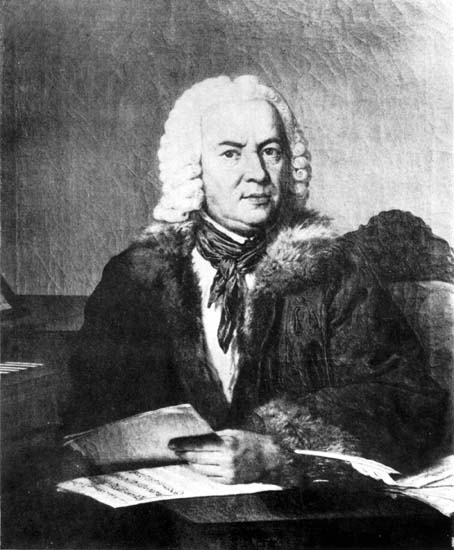
I now know this to be a portrait, evidently based on the 1748 Haussmann portrait, that dates from the early 1770s and that was the
handiwork of C. F. R. von Liszewsky (It disappeared during the Second World War.) and at one time the property of Frederick the
Great's sister, Amalia.

Bach, the intellectual fashion pate, the cultured clothes horse.
For Christmas in 1958, my oldest brother, Kenneth, who is a geologist, mineralogist, and scholar of world renown, gave me three
composer biographies dating from the turn of the 20th century that he had found. All were from the original "Master Musicians"
series, and one of them was C. F. Abdy Williams's biography of Bach. The frontispiece was yet another portrait that I had not seen
before.
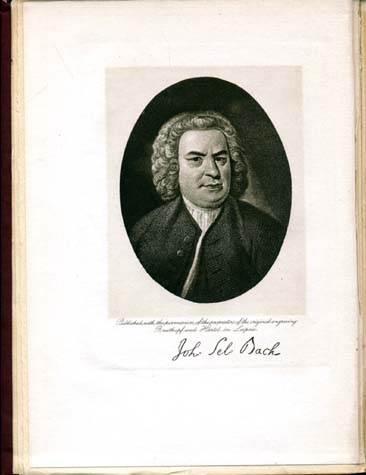
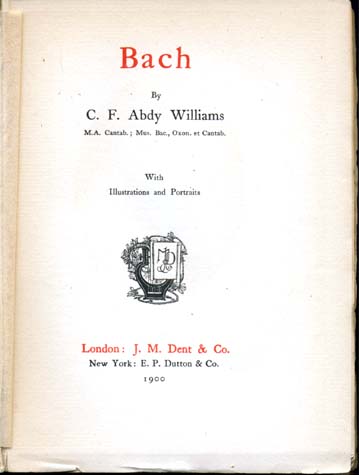
The frontispiece, I now know, is the Bollinger print of 1802, the earliest known print derived from the 1746 Haussmann portrait.
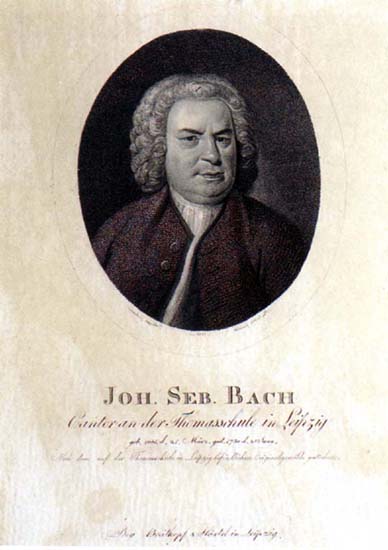
Next I encountered what I have nickamed the Clara Bow Portrait. In the United States, at least, it is even better known from the
Louis Lupas pastel adaptation than it is from the original engraving, which has its origins in a collection of idealized portrait prints of
great German composers that appeared in the third quarter of the 19th century, first in Germany and then in England. In those
dog-eat-dog days, before the signing of the Berne Copyright Convention of 1886 that put some teeth into international copyright
protection, this "vision" of Sebastian Bach was widely copied and pirated and was for many music lovers their only idea of what
Sebastian Bach looked like:
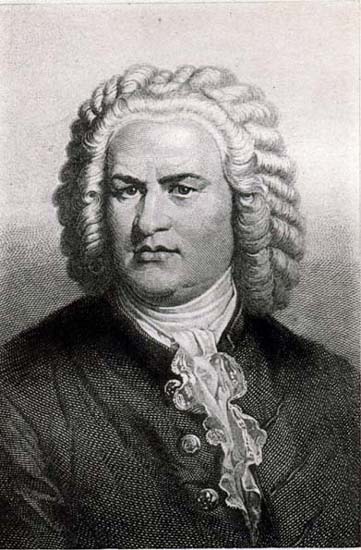
Goodness gracious, just look at those bee-stung lips. The "It Girl" would have been envious. The artist, Carl Jäger, derived "his"
Bach from the Haussmann face, of course, but he has not done all that well with a well intentioned attempt to create the face of a
"younger" Bach. But I saw this image, which was engraved by Johann Bankel, in one form or another, all the time in my fledgling
days as a record collector. It is the source of the portrait created for the album cover for Wanda Landowska's 1945 RCA Victor
recording of the Goldberg Variations, in all its early incarnations. This is how the cover art looks in the 45 RPM version,
WDM-1022:

I got the Landowska recording of the "Goldbergs" for Christmas when I was eleven. The following year, I bought my first
recording of the 4th, 5th, and 6th French Suites. The harpsichordist was Fernando Valenti, and the recording was on the
Westminster label. Once again, the Clara Bow Portrait provided the basis for the cover art:

At about this time, Esther Duffy, the then Performing Arts Librarian at the Greenwich Public Library, bent the rules and allowed me
to borrow records, even though I was nowhere near the minimum age of 16. It is a kindness for which I shall always be grateful. I
recall that one of the first recordings I borrowed was Agi Jambor's two record set of the Seven Toccatas and Four Fantasias
(Capitol SBR-8354), for over a decade the first and only recording of all of the Toccatas. The liner notes contained this image; it
was my first encounter with what is often the first image that pops into peoples' minds when you speak the words, "Bach portrait":
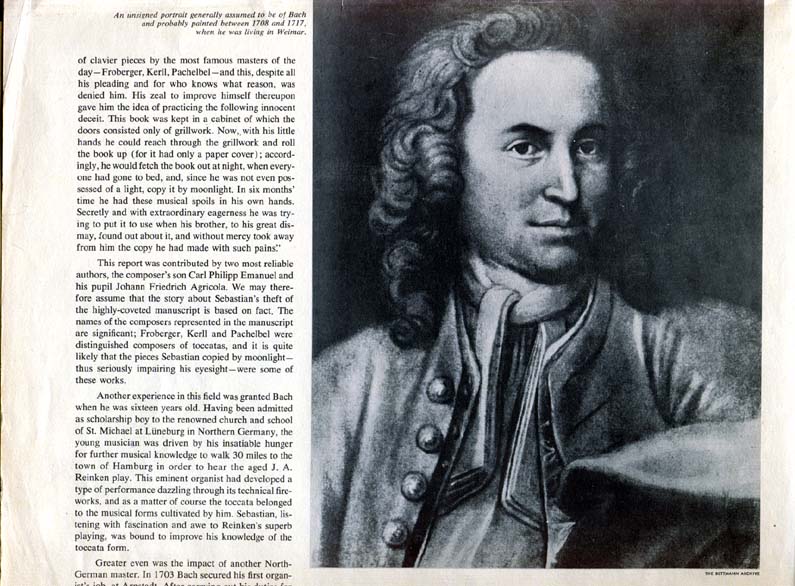
Even as an admittedly obnoxious "precocious brat" of a 7th grader, I took notice of the guarded and carefully worded caption: "An
unsigned portrait generally assumed to be of Bach and probably painted between 1708 and 1717, when he was living in Weimar".
This portrait, the existence of which was announced in 1907, is now in the city museum in Erfurt. Ubiquitous it may be, but it is an
image that I now know to be "fraught with peril", as W. C. Fields would put it. It took me many years to track the image down, but
here is an old photograph that shows what the painting, which I have since discussed in detail elsewhere here at The Face Of Bach,
looked like before the "restorers" got to it:

Under these circumstances, I am sure that it will come as no surprise to you to learn that, by the time I was 13, it was already "old
hat" for me to say to myself, "These are all supposed to be pictures of the same man?" and then ask myself, "What did Bach really
look like?"
My fascination, some would say my obsession, with Bach did not wane, by any means, as the years went on. Nurtured by
understanding parents, thoughtful brothers, and committed and supportive teachers, most importantly Paul Rotella of the Buckley
School (who also is responsible for nurturing and encouraging Hopkinson Smith, the world's premier lutenist, by the way), my
Bachophilia, if you will, grew by leaps and bounds, and I am sure that more than one of my teachers and classmates of yore
remember the Bach and the Beethoven sweatshirts! I was committted enough to my fascination with the face of Bach and my
passion for his music to put my admittedly limited talents as an artist to the ultimate test. As a 9th grader at the Greenwich Country
Day School, in Greenwich, Connecticut, in 1963, I undertook to paint my own copy of the familiar Haussmann portrait for my
spring project in Art:
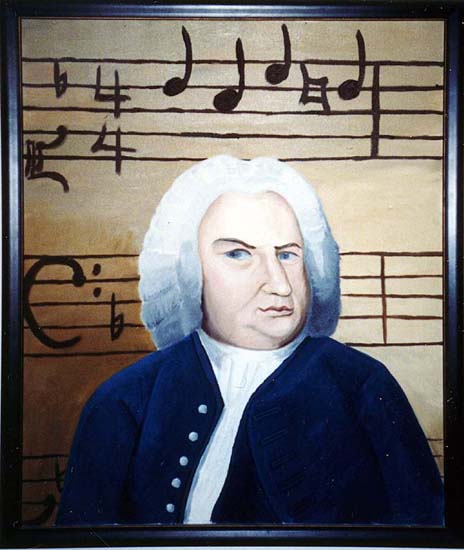
Not bad for a 9th grader of meagre artistic ability, if I do say so myself, but I can assure you that I was astute enough to quit while I
was ahead!
The following autumn, during the first weeks of my sophomore year at Deerfield Academy, in Deerfield, Massachusetts, I stumbled
across, in a green buckram bound copy of back issues of The Musical Quarterly, Prof. Gerhard Herz's meticulous, perceptive,
and scrupulously fair assessment of Heinrich Besseler's controversial and flawed but undeniably important monograph on the Bach
portraits, Fünf Echte Bildnisse Johann Sebastian Bachs (Cassel, 1956), 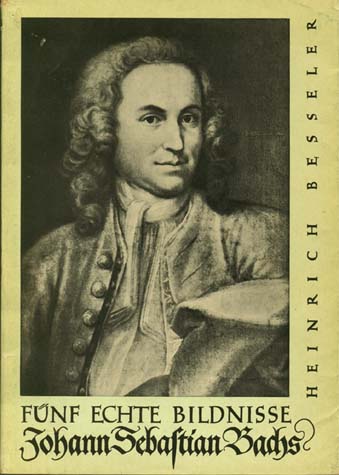 . After
reading that article and studying the illustrations that accompanied it, I was hooked, and I was hooked for good and all. The
illustrations that accompanied the review included two portraits of Bach that I had never seen before, the so-called Berlin Portrait,
on the left, and, on the right, the 1791 David copy of the 1746 Haussmann Portrait, both of which disappeared during World War II
and are assumed to have been destroyed in the bombings:
. After
reading that article and studying the illustrations that accompanied it, I was hooked, and I was hooked for good and all. The
illustrations that accompanied the review included two portraits of Bach that I had never seen before, the so-called Berlin Portrait,
on the left, and, on the right, the 1791 David copy of the 1746 Haussmann Portrait, both of which disappeared during World War II
and are assumed to have been destroyed in the bombings:
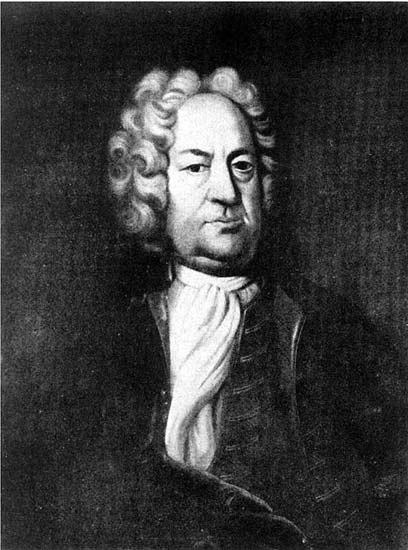
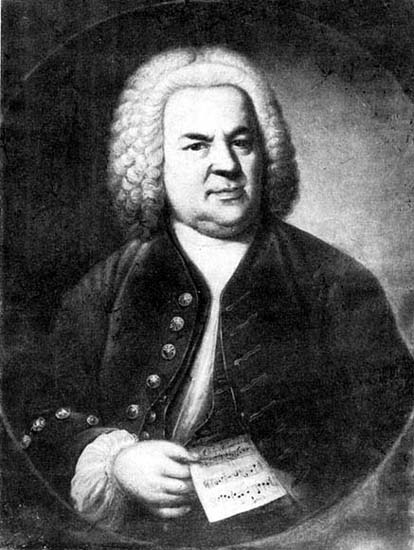
[A week after the presentation at Queens College, I learned from my friend and esteemed colleague, Christoph Wolff, that the David
portrait did, in fact, survive the War and has recently been located; it is now in the collection of the Bach Archiv, Leipzig. I soon
shall have to address the David copy, however, in major part because the more I study it and take into consideration the date and
the details of David's curriculum vitae, the more I think that his painting might be a "synthesis" of the 1746 and 1748 Haussmann
portraits.]
Another portrait alleged to be of Bach that also is illustrated in that article is one that I soon began to see with increasing frequency.
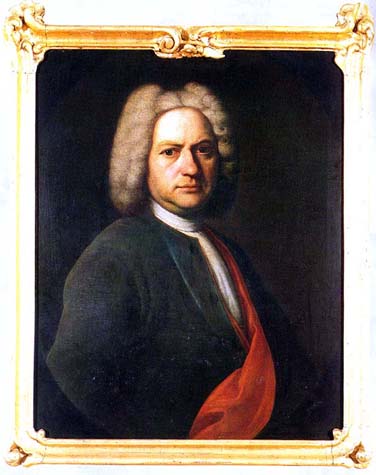
Purportedly by Johann Jakob Ihle and alleged to depict Bach during his tenure as Capellmeister in Cöthen, this portrait, like the
Erfurt portrait, has particular allure to recording company Art Directors in search of an image of a younger and more "accessible"
Bach. The first time that I can recall seeing it on a record jacket is the detail that is reproduced on the cover of the RCA Victor
domestic issue of Friedrich Tilegant's recording of the Brandenburg Concertos, which was released in this country in 1965:

Gerhard Herz's trenchant review of the Besseler book also contains a précis of the evidence and source materials for the Bach
iconography and a summary of the issues that are the Ursprung of all Bach iconographical discussions. Ever since, I have been
fascinated, some would say obsessed, by the problems, conundrums, and unanswered questions that plague the Bach iconography,
and for nearly four decades I have quietly pondered the images, the documentary evidence, the anecdotes, and the reception
history.
I tracked down Walther R. Volbach, the then owner of the Volbach portrait. He was a specialist in Theatre Arts, a disciple of
Appia, and a full Professor at Texas Christian University, and he, his wife, and the painting were in Forth Worth, Texas, at the time.
But, in the fall of the following year, they moved to Amherst, Massachusetts, which is a short drive from Deerfield, and shortly
thereafter I had my first encounter with an "original" Bach portrait, albeit a controversial one:

At about that same time, I wrote to Mr. Scheide for the first time, asking about the 1748 Haussmann portrait, of course. Things
arranged themselves in such a way that I went to college at Princeton, and, soon after my arrival, Mr. Scheide invited me over to his
house to see the original painting for the first time. I have had many, many more visits with it over the course of the past 34 years,
and I have come to think of the portrait as an old and treasured friend. It still hangs in the Scheide living room on Library Place,
precisely where it was hanging the first time that I saw it:

Please click on 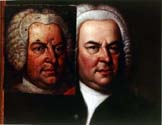 to advance to Page 2.
to advance to Page 2.
Please click on  to return to the Index Page at The Face Of Bach.
to return to the Index Page at The Face Of Bach.
Please click on  to visit the Johann Sebastian Bach Index Page at Teri Noel Towe's Homepages.
to visit the Johann Sebastian Bach Index Page at Teri Noel Towe's Homepages.
Please click on the 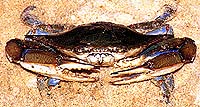 to visit the Teri Noel Towe Welcome Page.
to visit the Teri Noel Towe Welcome Page.
TheFaceOfBach@aol.com
Copyright, Teri Noel Towe, 2000 , 2001
Unless otherwise credited, all images of the Weydenhammer Portrait: Copyright, The Weydenhammer Descendants, 2000
All Rights Reserved
The Face Of Bach is a PPP Free Early Music website.

The Face Of Bach has received the HIP Woolly Mammoth Stamp of Approval from The HIP-ocrisy Home Page.